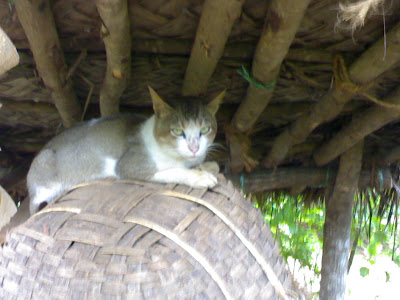 These waterfalls come to life only during the Monsoons, when there is a abundant flow of water in the myriad streams that join together to fall from a height, in the forest....
These waterfalls come to life only during the Monsoons, when there is a abundant flow of water in the myriad streams that join together to fall from a height, in the forest....
Pictures of my quaint little town, taken with Nokia N-97 - 5 mpx and Nokia N-70 - 2 mpx mobile cam. Karwar is the Head-Quarter of North Kanara district in Karnataka state, India, on the shores of the Arabian Sea. Surrounded by Western Ghat (mountains) on the East and South, the River Kali to the North, and the Arabian Sea, which comprises a chain of Islands.
Thursday, July 30, 2009
Just another Monsoon Waterfall....
 These waterfalls come to life only during the Monsoons, when there is a abundant flow of water in the myriad streams that join together to fall from a height, in the forest....
These waterfalls come to life only during the Monsoons, when there is a abundant flow of water in the myriad streams that join together to fall from a height, in the forest....
Wednesday, July 29, 2009
Paddy Fields - All done and waiting for the harvest in Sept-Oct

A paddy field is a flooded parcel of arable land used for growing rice and other semiaquatic crops. Rice can also be grown in dry-fields, but from the twentieth century paddy field agriculture became the dominant form of growing rice. Paddy fields are a typical feature of rice-growing countries of east, south and southeast Asia, including Cambodia, Bangladesh, China, India, Indonesia, Japan, Korea,Malaysia, Myanmar, Nepal, Pakistan, the Philippines, Sri Lanka,Taiwan, Thailand, and Vietnam. Paddy fields can be built adjacent to otherwise natural areas such as rivers or marshes. They can be constructed, often on steep hillsides with much labor and materials. The fields require large quantities of water for irrigation. Flooding provides water essential to the growth of the crop. Water also provides a favorable environment for the rice strains being grown as well as discouraging the growth of many species of weeds. More here... click
Monday, July 27, 2009
Tuesday, July 21, 2009
Monday, July 20, 2009
Wednesday, July 15, 2009
Of Tadpoles and Frogs....
 Reading this News Article, a few days back : Croak Croak no more... KARWAR: The sudden disappearance of frogs from the coastal areas of Uttara Kannada district has left environmentalists and health department officials worried. Environmentalists are concerned about many varieties of frogs being on the verge of extinction, while the health department officials are fighting a lone battle against chikungunya, dengue and malaria. The spurt in cases of chikungunya and dengue in the coastal taluks has highlighted the importance of amphibians like frogs that played a major role in controlling the mosquitoes, which spread the aforesaid epidemics. Also at http://frogsaregreen.com/651/frogs-natures-bug-zappers/
Reading this News Article, a few days back : Croak Croak no more... KARWAR: The sudden disappearance of frogs from the coastal areas of Uttara Kannada district has left environmentalists and health department officials worried. Environmentalists are concerned about many varieties of frogs being on the verge of extinction, while the health department officials are fighting a lone battle against chikungunya, dengue and malaria. The spurt in cases of chikungunya and dengue in the coastal taluks has highlighted the importance of amphibians like frogs that played a major role in controlling the mosquitoes, which spread the aforesaid epidemics. Also at http://frogsaregreen.com/651/frogs-natures-bug-zappers/Concerned over the drastic decline in population of frogs, Goa government has urged the public to refrain from catching them for commercial or other reasons during the monsoon, the mating season of many species of croakers.
The Indian government had banned catching, killing and export of frog legs under the Wildlife Protection Act 1972, thus entitling violators, including those serving frog meat at eateries, for stringent punishment like fine and imprisonment. The indiscriminate killing of frogs for their meat have been the cause of decline in their population, also disturbing the food chain and the ecological balance of terrestrial and aquatic ecosystems.
Tuesday, July 14, 2009
Landscape at Kadwad, Karwar
Monday, July 13, 2009
Monsoon lashes Karwar....
Wednesday, July 8, 2009
A Village House










